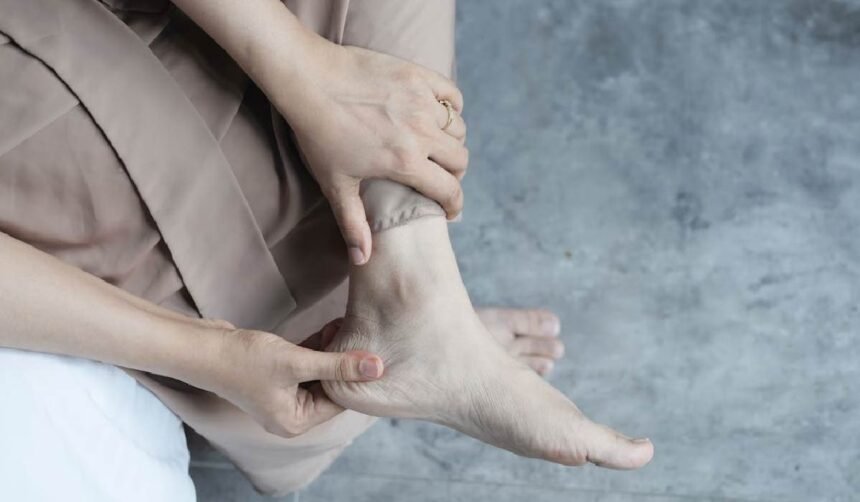Picture this: A casual city stroll, then a burning throb by the time you reach the café. The cause isn’t always dramatic. Small habits stack up. Gait patterns whisper problems before they shout. Let’s break it down with clear, practical fixes you can use today.
Common Walking Mistakes That Lead to Foot Pain
- Overstriding: long steps drive the heel like a brake, spiking impact with every contact.
- Low cadence: slow, heavy steps pound joints; aim for a quicker rhythm to spread the load.
- Locked knees: stiff legs pass shock upward; soft knees act like springs.
- Lazy toes: toes that never splay reduce balance and grip on push-off.
- Side-to-side sway: hips drifting starves ankles of stability and control.
- Phone gaze: a forward head shifts weight, crushing the front of the shoe.
How Improper Footwear Causes Unexpected Discomfort
Shoes act like translators between the ground and the body. A narrow toe box squashes alignment and rubs skin raw. Excess heel lift shortens calves and overworks plantar tissues. Cushy foam feels friendly in the store, yet can mute the feedback you need for precise movement. Thin, flat soles without grip can slip at mid-stance and strain stabilizers. Even laces matter; loose lacing lets the heel slide, tight lacing pinches nerves on the top of the foot. Try a shape that follows natural toe spread, moderate stack height, and reliable traction. Break pairs in gradually. Rotate models to vary stress patterns across the week.
The Role of Foot Mechanics in Walking Pain
Your gait is a chain reaction. Heel strike angle sets the stage for what ankles, knees, and hips must absorb. Excess inward roll can tug the plantar fascia; too much outward roll stresses the fifth metatarsal. Short, quick steps usually lower collision forces. Arm swing matters more than it seems; relaxed arms help hips rotate and keep the trunk steady. Foot shape, strength, and flexibility dictate how you load the forefoot at push-off.
Curious about natural foot shape and roomy toe boxes? Explore options like Rutsu Barefoot Shoes. A wide platform, flexible sole, and light weight can improve ground feel and encourage better mechanics over time. Transition slowly to let tissues adapt. Add short, easy walks first. Sprinkle in foot strength work so form keeps up with freedom.
Hidden Medical Conditions Behind Sore Feet After Walking
Sometimes the issue hides under the surface. Plantar fasciitis creates sharp morning steps that ease, then flare later. A Morton’s neuroma zaps the forefoot with tingling and burning between the toes. Stress reactions announce themselves with pinpoint tenderness that worsens day by day. Arthritic changes stiffen joints and limit shock absorption. Nerve entrapments cause numb patches or electric sparks on push-off. Circulation problems bring cramping that eases with rest. Red flags include swelling that won’t quit, fever, night pain, or a change in foot color or temperature. See a clinician for imaging or a thorough exam if those show up.
Why Flat Feet or High Arches Make Walking Painful
Arch height changes how the load travels. A low arch often collapses under load, pulling the fascia like an overstretched bowstring. A high arch acts like a rigid bridge; force doesn’t spread, and hotspots build under the heel and big toe. Both patterns can be strong and healthy with the right inputs. Strengthen the intrinsic muscles with short-foot drills, toe spreading, and towel curls. Mobilize the big toe; a stiff big toe steals propulsion from the calf and hamstring. Choose footwear that matches your structure: roomy forefoot, stable midfoot feel, and just enough flexibility to let muscles work without chaos.
The Link Between Body Alignment and Foot Fatigue
Your base reflects everything above it. A forward head load the forefoot. Rounded shoulders, shut down arm swing, and twist the pelvis. Weak glutes let the knee cave inward, which drags the arch with it. Build alignment from the ground up and the top down. Practice tall posture: crown of the head up, ribs stacked over pelvis, hips level. Train single-leg balance so ankles and hips talk to each other. Add calf raises, tibialis work, and hip abduction sets. On your next stroll, think “quick-light-quiet.” The sound of each step is free biofeedback.
Conclusion: Fixing Foot Pain Starts With Awareness, Not Assumptions
Small upgrades flip the script. Sharpen cadence. Choose shoe shapes that respect toe spread. Strengthen what supports you. Watch posture. If symptoms linger or escalate, book an assessment and get a personalized plan. Smart tweaks today save you from bigger problems tomorrow.
FAQs
How can I tell if my shoes are the problem?
Check for toe dents on the upper, blisters on the sides of the big or little toe, and a worn-out outer heel. If you feel sliding or pinching, the shape or lacing is off. Try a wider forefoot, a lower heel lift, and a snug heel lock.
What simple exercises help right away?
Start with calf raises, toe spreading, and short-foot holds. Add slow, controlled single-leg balances near a wall. Ten minutes, three to four days per week, builds a strong platform.
Is all cushioning helpful?
Not always. Soft foam can mask impact and reduce feedback. Balanced cushioning that lets you sense the ground often leads to cleaner form and fewer hotspots.
How fast should I transition to flexible footwear?
Go slow. Begin with brief, easy sessions on flat ground. Add a few minutes each outing. If soreness lingers the next day, back off and progress more gradually.
When should I see a professional?
Seek care if you notice night pain, visible swelling that sticks around, sudden bruising without a clear cause, numbness, or a change in skin temperature or color. Those signs call for a proper exam and, possibly, imaging.







